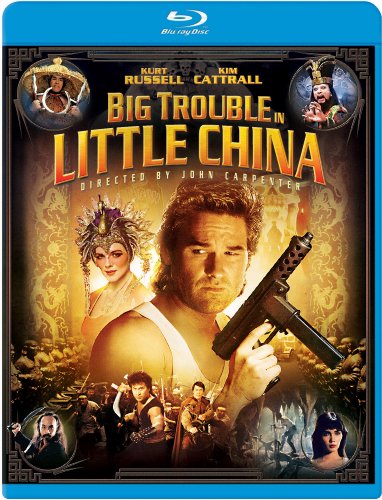 1986 saw director John Carpenter at the height of his career; a string of staggering successes charting back to HALLOWEEN and including THE FOG, ESCAPE FROM NEW YORK, THE THING and CHRISTINE represent a creative peak that any director would be jealous of. 1984’s STARMAN not only buoyed the streak; it gave Carpenter the critical raves that often eluded genre directors. Taken in hindsight, there isn’t another filmmaker that we can think of – regardless of genre – who has been able to produce six legitimate classics in as many years. Major studios were eager to work with Carpenter, and there was even a flirtation with the Salkind’s ticking time bomb, SANTA CLAUS: THE MOVIE before demands for creative control lost him the job – he should have just phoned Richard Donner and saved time. Instead, Carpenter’s next project would be an oddball genre gumbo: an action film taking place almost entirely beneath San Francisco’s Chinatown and emphasizing Chinese mysticism and martial arts long before Hollywood began importing Hong Kong talent to choreograph THE MATRIX, CHARLIE’S ANGELS, et al. BIG TROUBLE IN LITTLE CHINA’s $25 million budget was by far the largest Carpenter had yet worked with, and not even adjusting that figure for inflation gives a proper indication of how big a price tag that was for an action-fantasy-comedy in 1986.
1986 saw director John Carpenter at the height of his career; a string of staggering successes charting back to HALLOWEEN and including THE FOG, ESCAPE FROM NEW YORK, THE THING and CHRISTINE represent a creative peak that any director would be jealous of. 1984’s STARMAN not only buoyed the streak; it gave Carpenter the critical raves that often eluded genre directors. Taken in hindsight, there isn’t another filmmaker that we can think of – regardless of genre – who has been able to produce six legitimate classics in as many years. Major studios were eager to work with Carpenter, and there was even a flirtation with the Salkind’s ticking time bomb, SANTA CLAUS: THE MOVIE before demands for creative control lost him the job – he should have just phoned Richard Donner and saved time. Instead, Carpenter’s next project would be an oddball genre gumbo: an action film taking place almost entirely beneath San Francisco’s Chinatown and emphasizing Chinese mysticism and martial arts long before Hollywood began importing Hong Kong talent to choreograph THE MATRIX, CHARLIE’S ANGELS, et al. BIG TROUBLE IN LITTLE CHINA’s $25 million budget was by far the largest Carpenter had yet worked with, and not even adjusting that figure for inflation gives a proper indication of how big a price tag that was for an action-fantasy-comedy in 1986.
We must have thought that the film’s trailer was pretty good at 16, because we arrived dutifully early on that Independence Day weekend when the film opened, even though it turned out that we could have sat anywhere we wanted to in the nearly empty theater. Big Trouble in Little China recouped less than half its budget, sending Carpenter running back in the world of independent cinema, only to return twice – in 1992 to ruin H F Saint’s beautiful novel Memoirs of an Invisible Man with a sadly risible film version starring Chevy Chase, and again in 1996 in an attempt to ruin his own legacy with Escape From L.A. But we weren’t thinking, while sitting in that near-empty theater on the 4th of July all those years ago, that the film about to unspool would represent Carpenter’s last great creative leap forward – an orgasmic discharge that mixed ’30s screwball slapstick with ’70s Shaw Bros Kung-Fu, and wrapped in director of photography Dean Cundey’s trademarked Panavision flair. Carpenter would never get the keys to the candy store on this scale again.
If you’re reading this, then the chances are that you’re already familiar with the tale of Jack Burton and the Pork Chop Express (that would, of course, be his truck.) After dropping off his freight in San Francisco, Jack meets up with old friend Wang (the criminally underused Dennis Dun, who bookended Big Trouble in Little China with superior turns in Year of the Dragon and The Last Emperor) and drives him to the airport to pick up his fiancée from China. Also awaiting the plane are henchmen of the Wing Kong, a street gang working for David Lo Pan (the great James Hong, now 80 and still going strong), the leader of Chinese underworld in San Francisco who also happens to be a 200 year old wizard, cursed to walk the Earth until he marries and then sacrifices a girl with green eyes.
On their way to Lo Pan’s HQ to retrieve Wang’s bride-to-be, Jack and Wang wind up in the middle of a full-scale kung-fu showdown between the Wing Kong and the Chang Sing; but just as the Sing appear to gain the upper hand, 3 supernatural furies arrive – with powers representing lightning, thunder, and rain – and decimate the Chang Sing. Jack and Wang make an understandable dash for safety, but return to find Jack’s beloved truck gone. While regrouping at the home of tour bus driver and benevolent sorcerer Egg Shen (more memorable character work from the late Victor Wong, who’s death on 9/12/01 went sadly, but understandably, unreported), Jack and Wang pick up help from investigative reporter Gracie Law (Kim Cattrall, showing great chemistry with Russell that should have been capitalized on in other films). Soon this motley crew is off to Lo Pan’s mystical underground lair to retrieve Jack’s truck, Wang’s bride, and stop an ancient evil from spreading across the globe.
Now, if that brief synopsis makes sense to you – seek help, fast. The plot of Big Trouble in Little China reads like an opium hallucination and must have had executives at Fox more than a little anxious. While the Asian actors are uniformly great (particularly Victor Wong and James Hong who look like they’re having a blast), playing their roles with a wink, the success of the film rests squarely on the shoulders of star Russell. At the outset, Jack Burton appears to be a typical square-jawed hero in the Carpenter mode – a sarcastic Snake Plissken. But as the film progresses, we notice that Burton, who walks into every scene wearing a cocky half-sneer and spouting one eminently quotable line after another (usually mentioning himself in the 3rd person), is being used almost entirely for comic effect. Outrageous action happens around Burton, who never seems to get a handle on the mystical donnybrook that swirls around him.
Big Trouble in Little China gets endless mileage out of Russell’s pitch-perfect comic delivery: from his “Where’d you get that?” reaction when an opponent whips out a kung-fu weapon at the airport, to the frustrated shooting of a grotesque floating head during the climax (“Hey, you never know ‘till you try”), Russell earns buckets of laughs almost effortlessly. This is likely the prime reason the film failed to click with mass audiences; Fox pushed Carpenter’s tongue-in-cheek adventure as a straight(ish) action piece, leaving lots of head scratching when the hero fires off a celebratory round of gunfire moments before the final action confrontation, only to be hit in the head by a chunk of ceiling and get knocked out cold for much of the fight. At the time, we thought that was the funniest thing we had ever laid eyes on, and little has happened since to amend that statement.
But for those who knew what the ride would be like when they bought the ticket, Big Trouble in Little China played like a dream come true. Younger folk who weren’t part of the movie-going public in 1986 probably can’t appreciate just how huge it was to have a large-scale Hollywood film embrace the Hong Kong martial arts shooting style on this scale. This was years before Jackie Chan, John Woo and Chow Yun-Fat broke down the walls of acceptance for HK cinema’s distinct style, and for those that were amenable to it, it was like having someone clean a filthy windshield and finally being able to see the world as it was meant to be seen. If this all sounds a bit too much, take a look at what was passing for action films in the earlier part of the decade, replete with listless warehouse shootouts and endless, stultifying shots of stuntmen flying off of trampolines. Somehow, Carpenter found a way to successfully fold these elements into the comic framework of Russell’s Jack Burton, creating this odd-duck masterpiece. We revisit this show just about annually to marvel at his weaving together of such desperate elements and lament the creative spiral that began for the director not long after this film’s release.
BLU-RAY DETAILS
Fox’s eagerly awaited Blu-Ray of Big Trouble in Little China adds a DTS isolated score track, but otherwise appears to be a reissue of their 2-disc DVD set of several years back. We’re very pleased to report that the Blu-Ray looks fabulous, offering a giant leap in terms of color and detail over the previous 2-disc edition. We can only hope that every vintage film gets this sort of treatment.
A selection of deleted scenes and an extended ending (many of which are from a workprint) are on-hand, in addition to a featurette from 1986. A BTS stills gallery is included, along with the original theatrical trailer, to give an indication of what Fox thought the best marketing route would be. (There’s no question that the film was a tough sell; who is this Jack Burton guy anyway? Is he a joke? Why does he spend half of the film’s final fight scene unconscious? ) We’re sure that Ms. Cattrall’s agent enjoyed seeing her prominent billing on the disc artwork (is Fox shooting for Sex and the City fans?) though Mr. Russell’s might feel differently.
The most important extra, however, is the commentary track featuring Carpenter and Russell. They’ve previously recorded chats for Escape from New York and The Thing (though all three are several years old by now), and their tracks together have long been considered the high watermark of the art form; it may sound trite, but it truly is like sitting with two friends reminiscing over dinner. On the Big Trouble in Little China commentary track, Carpenter and Russell lay into the Fox marketing dept hard, placing a lot of the blame for the film’s dismal box office performance at their feet. Carpenter is wildly unpredictable on his own, but like their film collaborations, being in each other’s company seems to bring out the best in each other.
May the wings of liberty never lose a feather.
[serialposts]
 Hey, you! Mr. CGI development guy – I’m talking to you! The one who created the software that renders those splashy red blotches of computer-generated “blood” that fly across the screen throughout BLOOD :THE LAST VAMPIRE – I am calling you out. What the hell were you thinking? You toil in your workshop like a mad scientist fiendishly laboring over some hideous experiment in his lab, and when finished, instead of having a last-minute pang of conscience and destroying your misbegotten creation before it falls into the wrong hands, you deliver it to some hack-tacular filmmakers who use it with all the finesse of a five-year old who inadvertently got his hands on daddy’s paint gun. The results are about as fun as watching somebody shake up a bottle of champagne before popping the cork: it’s good for a giggle the first time, but after 90 minutes – hell, after ten minutes – it gets really old.
Hey, you! Mr. CGI development guy – I’m talking to you! The one who created the software that renders those splashy red blotches of computer-generated “blood” that fly across the screen throughout BLOOD :THE LAST VAMPIRE – I am calling you out. What the hell were you thinking? You toil in your workshop like a mad scientist fiendishly laboring over some hideous experiment in his lab, and when finished, instead of having a last-minute pang of conscience and destroying your misbegotten creation before it falls into the wrong hands, you deliver it to some hack-tacular filmmakers who use it with all the finesse of a five-year old who inadvertently got his hands on daddy’s paint gun. The results are about as fun as watching somebody shake up a bottle of champagne before popping the cork: it’s good for a giggle the first time, but after 90 minutes – hell, after ten minutes – it gets really old.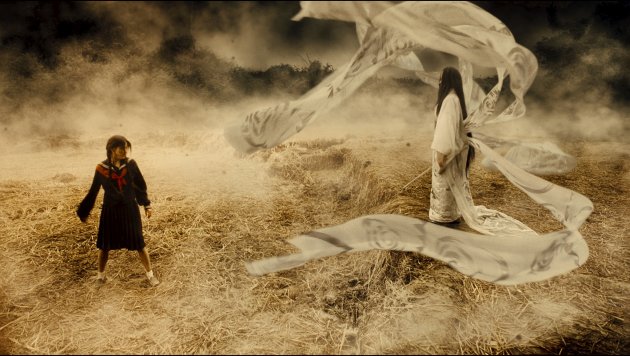
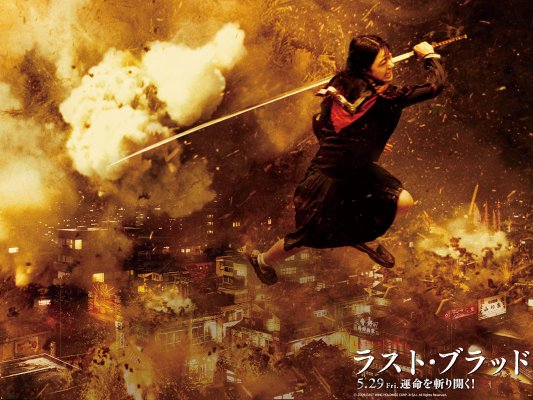
 CHANBARA BEAUTY (Onechanbara, Japan, 2008) is geek paradise: two gorgeous babes and a fat dude wander around the countryside killing zombies. One is a gorgeous sharpshooter who never misses. The other is a samurai in Western hat and serape – and little else save for a fuzzy bikini; she is the title Chanbara Beauty (the term chanbara in Japanese refers to sword-fighting movies; the term beauty refers very accurately to the lead character).
CHANBARA BEAUTY (Onechanbara, Japan, 2008) is geek paradise: two gorgeous babes and a fat dude wander around the countryside killing zombies. One is a gorgeous sharpshooter who never misses. The other is a samurai in Western hat and serape – and little else save for a fuzzy bikini; she is the title Chanbara Beauty (the term chanbara in Japanese refers to sword-fighting movies; the term beauty refers very accurately to the lead character). CHANBARA BEAUTY THE MOVIE: VORTEX (Japan, 2009) – the inevitable direct-to-DVD sequel – still has the primary draws of the former film (lots of zombies and swordplay, samurai babe wearing fuzzy bikini aided by younger samurai babe in school girl outfit) but lacks entirely the luster and interest of the first film.
CHANBARA BEAUTY THE MOVIE: VORTEX (Japan, 2009) – the inevitable direct-to-DVD sequel – still has the primary draws of the former film (lots of zombies and swordplay, samurai babe wearing fuzzy bikini aided by younger samurai babe in school girl outfit) but lacks entirely the luster and interest of the first film.
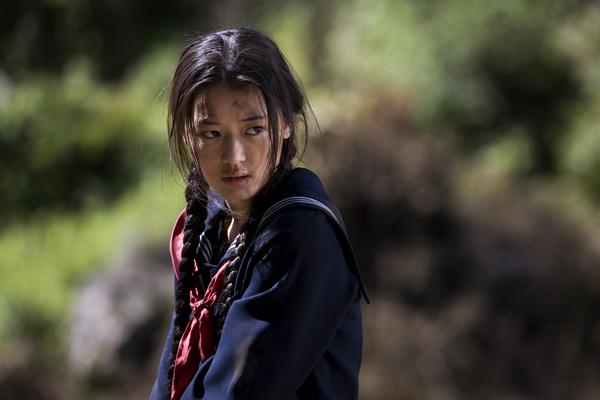 BLOOD: THE LAST VAMPIRE is a live-action horror film based on the 2001 anime short subject of the same title. Shot in the style of a Hong Kong fant-asia film, with lots of martial arts swordplay choreographed by Corey Yuen (THE ONE, X-MEN), BLOOD: THE LAST VAMPIRE is a Chinese-French co-production, with a French director (Chris Nahon – KISS OF THE DRAGON), a Chinese screenwriter (Chris Chow – THE EYE 3) and a Chinese producer (Bill Kong – CROUCHING TIGER, HIDDEN DRAGON), and an international cast. Irishman Liam Cunningham (Dario Argento’s THE CARD PLAYER) is Michael, agent of a super-secret organization tracking down vampires on an American airbase in Japan during the Vietnam War. Japanese actress Koyuki (KAIRO, a.k.a. “Pulse”) is Onigen, the vampire queen who is the ultimate target of Michael’s organization. And Korean star Gianna Jun is Saya, the half-human vampire-hunter hybrid who works as Michael’s assassin in order to further her own quest for revenge against the demons that killed her father.
BLOOD: THE LAST VAMPIRE is a live-action horror film based on the 2001 anime short subject of the same title. Shot in the style of a Hong Kong fant-asia film, with lots of martial arts swordplay choreographed by Corey Yuen (THE ONE, X-MEN), BLOOD: THE LAST VAMPIRE is a Chinese-French co-production, with a French director (Chris Nahon – KISS OF THE DRAGON), a Chinese screenwriter (Chris Chow – THE EYE 3) and a Chinese producer (Bill Kong – CROUCHING TIGER, HIDDEN DRAGON), and an international cast. Irishman Liam Cunningham (Dario Argento’s THE CARD PLAYER) is Michael, agent of a super-secret organization tracking down vampires on an American airbase in Japan during the Vietnam War. Japanese actress Koyuki (KAIRO, a.k.a. “Pulse”) is Onigen, the vampire queen who is the ultimate target of Michael’s organization. And Korean star Gianna Jun is Saya, the half-human vampire-hunter hybrid who works as Michael’s assassin in order to further her own quest for revenge against the demons that killed her father. Gianna (whose real name is Jun Ji-hyun, also spelled Jeon Ji-hyeon) is a popular actress and product-pitchwoman in her native country, most well known for romantic comedys like MY SASSY GIRL (2001), for which she won a Best Actress award at the Daejong Film Festival. BLOOD: THE LAST VAMPIRE is her first horror film, but she has appeared in other types of cinefantastique, usually love stories with romantic overtones, such as WINDSTRUCK and IL MARE (2000), the latter of which was remade as THE LAKE HOUSE with Keanu Reeves and Sandra Bullock. Although some of her titles are available on DVD in the U.S., BLOOD: THE LAST VAMPIRE (which is her first English-language film) is the first to receive a relatively high-profile theatrical release in North America, making it her debut for most American viewers.
Gianna (whose real name is Jun Ji-hyun, also spelled Jeon Ji-hyeon) is a popular actress and product-pitchwoman in her native country, most well known for romantic comedys like MY SASSY GIRL (2001), for which she won a Best Actress award at the Daejong Film Festival. BLOOD: THE LAST VAMPIRE is her first horror film, but she has appeared in other types of cinefantastique, usually love stories with romantic overtones, such as WINDSTRUCK and IL MARE (2000), the latter of which was remade as THE LAKE HOUSE with Keanu Reeves and Sandra Bullock. Although some of her titles are available on DVD in the U.S., BLOOD: THE LAST VAMPIRE (which is her first English-language film) is the first to receive a relatively high-profile theatrical release in North America, making it her debut for most American viewers. 
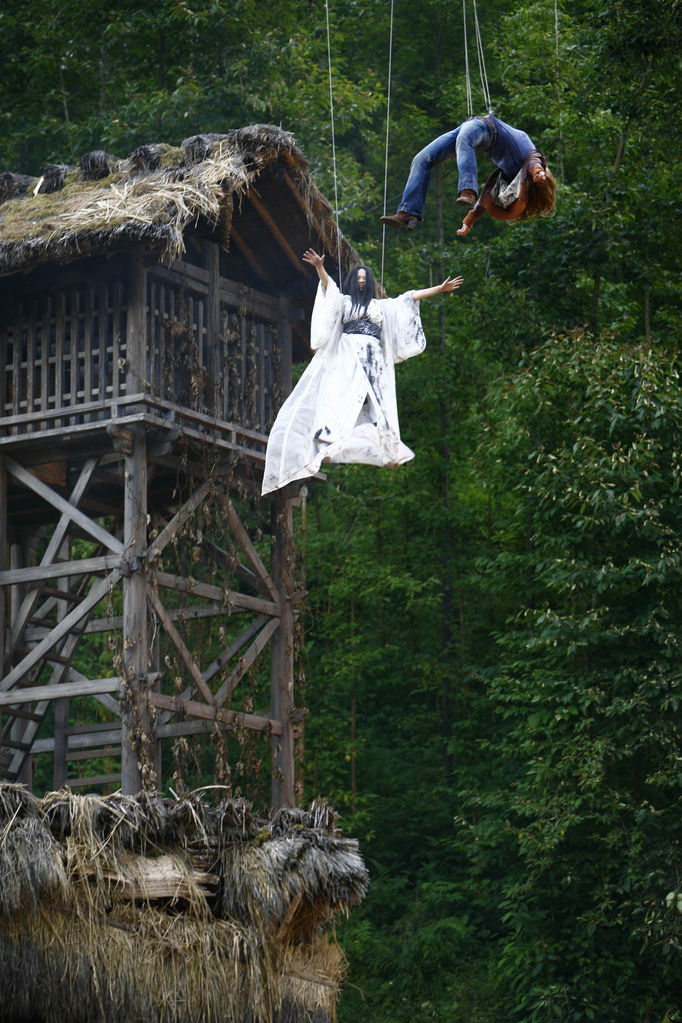

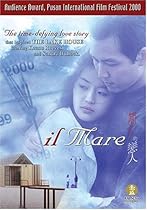

 THIRST – a new “vampire romance” from Korean writer-director Park Chan-wook (LADY VENGEANCE,
THIRST – a new “vampire romance” from Korean writer-director Park Chan-wook (LADY VENGEANCE,  The weekend’s one fantasy film debut, DRAGONBALL EVOLUTION, was a dud at the box office. Directed by James Wong (FINAL DESTINATION), the adaptation of the popular anime franchise failed to ignite despite the presence of Chow Yun-Fat (CROUCHING TIGER, HIDDEN DRAGON) and James Marsters (BUFFY THE VAMPIRE SLAYER). Making its debut in 2,181 North American theatres, the film earned only $4.76-million, bouncing into 8th place.
The weekend’s one fantasy film debut, DRAGONBALL EVOLUTION, was a dud at the box office. Directed by James Wong (FINAL DESTINATION), the adaptation of the popular anime franchise failed to ignite despite the presence of Chow Yun-Fat (CROUCHING TIGER, HIDDEN DRAGON) and James Marsters (BUFFY THE VAMPIRE SLAYER). Making its debut in 2,181 North American theatres, the film earned only $4.76-million, bouncing into 8th place.